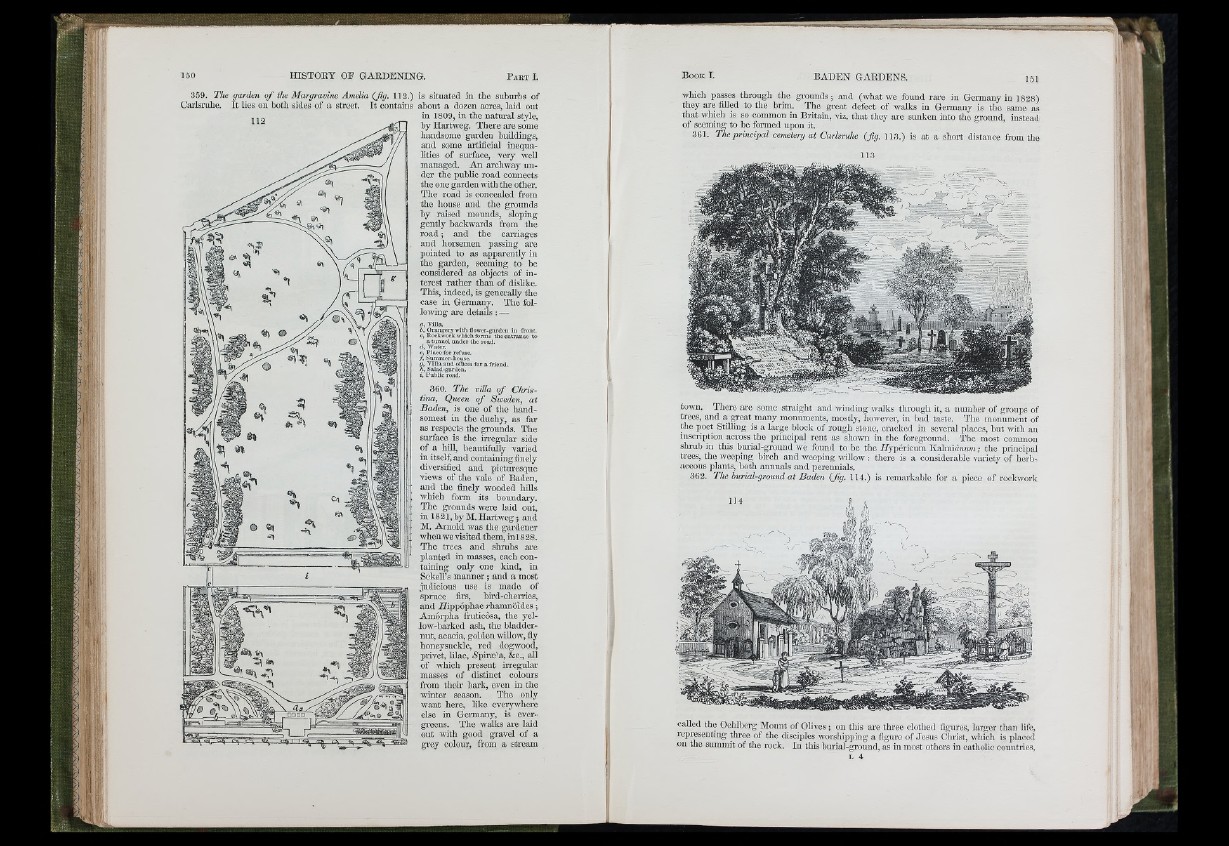
h i
II’
; • iii
359. The garden o f the Margravine Amelia (fig. 112.) is situated in the subui'bs of
Carlsruhe. I t lies on both sides of a street. It contains about a dozen acres, laid out
in 1809, in the natui-al style,
by Hartweg. There ai'e some
handsome gai'den buildings,
and some artificial inequalities
of suiface, very weU
managed. A n archway under
the public road connects
the one garden with the other.
The road is concealed from
the house and the grounds
by raised mounds, sloping
gently backwards from the
ro a d ; and the can-iages
and horsemen passing arc
pointed to as apparently in
the garden, seeming to be
considered as objects of interest
rather than of dislike.
This, indeed, is generally the
case in Germany. Tlie following
ai'e de ta ils: —
a, VUIa.
h, Orangery with flower-garden in front.
c, Rockwork which fornis the entrance to
a tunnel under tlie road.
d. Water.
e. Place for refuse.
f, Summer-house.
if. Villa and offices for a friend.
?4, Salad-garden.
i, Public road.
360. The villa o f Christina,
Queen o f Sweden, at
Baden, is one of the handsomest
in the duchy, as far
as respects the grounds. The
surface is the in'egular side
of a hill, beautifully varied
in itself, and containing finely
diversified and picturesque
views of the vale of Baden,
and the finely wooded hills
wliich form its boundary.
The grounds were laid out,
ill 18 21, by M. H a rtw eg ; and
M. Arnold was the gardener
whenwevisited them, inl828.
Th e trees and shrubs are
planted in masses, each containing
only one kind, in
Sckell’s m an n e r; and a most
judicious use is made of
spmce firs, hii-d-chemes,
and Jiippophae rhamnoides;
Amorpha fniticosa, the yellow
barked ash, the bladder-
nut, acacia, golden willow, fly
honeysuckle, red dogwood,
privet, lilac, Npirai'a, &c., all
of which present irregular
masses of distinct colours
from their bark, even in the
winter season. The only
want here, like evei-ywhere
else in Germany, is evergreens.
The walks are laid
out with good gravel of a
gi'cy colour, from a stream
BADEN GARDENS. 151
which passes through the grounds; and (what wc found rare in Germany in 1828)
they are filial to the brim. The great defect of walks in Germany is the same as
that which is so common in Britain, viz, that they are sunken into the gi-ound, instead
of seeming to be foimed upon it.
361. The principal cemetery at Carlsruhe ( fg . 113.) is at a short distance from tlie
town. There are some straight aud winding ivalks through it, a number of groups of
trees, and a great niany monuments, mostly, liowevcr, in bad taste. The monument of
the poet Stilling is a large block of rough stone, cracked in several places, but with an
inscription across tlie principal rent as shown in tlie foreground. The most common
shrub in this bm'ial-ground we found to be the 7/ypericum KalmiunR/«; the principal
trees, the weeping birch and weeping willow : there is a considerable variety of herbaceous
plants, both annuals and peremiials,
362. The burial-ground at Baden (fig. 114.) is remarkable for a piece of rockwork
called the Ochlbcrg Mount of Olives ; on tliis arc three clothed figures, larger than life,
representing three of the disciples worshipping a figure of Jesus (jjirist, which is placed
on the summit of tho rock. In this burial-ground, as in most others in catholic countries,
L 4